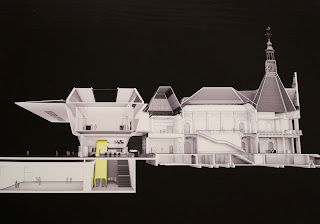Utrecht - HKU
So a new cultural Wedensday with our two new tutors - and its been a good one!
Over the last week, our task had been to collect all our rubbish...well all things that wouldn't rot or decompose in the mean time...or certain unmentionables. So we each came to class dragging our bags of rubbish - some noticeably bigger than others.
This cultural Wednesday, our theme was 'duurzaamheid' - sustainability. We spend the first few hours of class discussing different aspects of sustainability - looking at a variety of examples and issues.
Our fist task of the day was to get together in groups of three, and answer the following three questions:
In terms of sustainability:
1. What is nonsense/'bullshit'?
2. What is interesing?
3. What can we do as a designer?
Interestingly, there were a lot of similar answers within the class.
1.
+ There was a lot of mention of all the claims by products to be 'sustainable' or 'ecologically friendly' when they're not. For example a mayonaise that claimed to be eco friendly because they used free range eggs. However the oil they used did more than enough damage to outweigh the good.
+ Companies that claim to be green purely to create advertising advantage.
+ The fact that some people still don't think sustainability is an issue worth talking about.
+ I also think its also nonsense that so many people talk big and talk green, but don't do anything about it.
+ We're so focused on trends and fashion fads - so many things are bought just to last for the 'season', then to be replaced by some thing new. How wasteful.
2.
+ Thinking creatively and innovatively about a serious problem to create something that reduces the issue and perhaps adds to/improves our lifestyle
+ A lot of people mentioned the electric car
+ How a few small changes in our lifestyle can make a big difference in the long run
+ All the new innovative designs being produced as a reaction/ in response to the issue.
3.
+ Its our responsibility to think of more sustainable options/ solutions
+ Take a stand for sustainability and act on it
+ Look at the way we use materials, what materials we use, new ways of manipulating old materials
+ Look at the whole product/design life cycle - what happens at the end? Thinking long term rather than short term
+ Ways of extending the life of existing products/materials/designs - altering, upgrading, adding, recycling
I can keep on going!
Our next task was to look at our weeks worth of rubbish and order it into some sort of form. People looked at colour, time of day, size, calories etc. and used a form to reflect this.
I had some small cardboard model pieces that I'd used to create the floor plans of one of my designs. I'd labled them all with the spaces they represented. So I used these, in combination with the rubbish to create a 'floor plan' or 'footprint' of where my rubbish is created.
After reducing my little creation back into a pile of rubbish, I made my way back to the lecture hall.
When I walked in, I saw a growing pile of refuse growing in the middle of the lecture hall and was told to add my load to the pile...pretty impressive collection. 80 students and 1 week:
After splitting into groups of 5 (roughly :P) we were told make a collection of items. We had to choose what elements we'd look for - eg. colour, size, ability to be blown-up, health foods
I'd suggested bottle tops...seemed like a fun thing to collect, and everyone was pretty happy to give us the bottle tops from their collection. We started organising them in colour and it became a happy little collection:
On the way down to the canteen we decided to recycle the bottle tops, and give them a second life - as a lampshade. We decided to hijack one of the existing lamps in the canteen, and give it a little makeover.
We organised in colour, and then started with the most prominent colour - blue, then continuing with contrasting/complimentary colours to keep it exciting.
And for one of the other groups, took this little video...so thought I'd post it for them.
























































